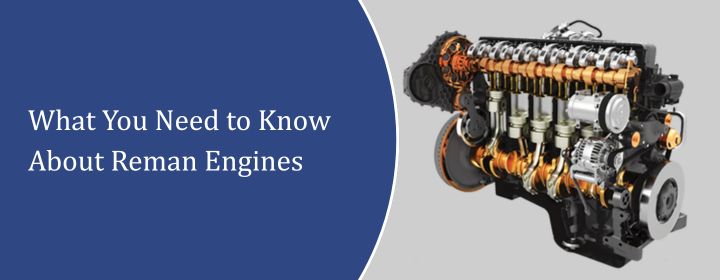
What You Need to Know About Reman Engines
Remanufactured or reman engines are factory-rebuilt units which are designed to match with the original equipment specifications. It combines the original engine cores with replaced internal components. These reman engines outperforms the rebuilt or used engines in reliability and still cost you less than a brand-new motor. For anyone considering a replacement, reman engines offer a balance of quality, value, and performance. Here this guide will breaks down what reman engines are, when they make sense, pros and cons, and key considerations to make a smart purchase.
What Exactly Are Reman Engines?
A reman engine starts as a factory- or dealer-sourced core then enters a controlled rebuild process:
- Complete Disassembly: Every part is removed for inspection and measurement.
- Machining Standards Applied: Critical parts are machined as per the specification.
- New Components Installed: Components like the bearings, piston rings, gaskets, seals, and belts are brand-new.
- Final Assembly and Testing: In the end, units are assembled using précised guide. Also, runs dyno and leak tests for inspection.
After following this process, it results with an engine engineered to meet new OEM tolerances. Technically it is not brand-new engine but these reman engines are built to factory specifications and often include a warranty similar to original units.
When Reman Engines Make Sense
Failed or Damaged OEM Engine
If your vehicle’s engine has lost compression, blown seals, or major internal damage then a reman engine can restore its OEM performance without the price tag of new.
Warranty Restoration
Installing a reman engine usually includes a factory-grade warranty which makes it a suitable for long-term ownership or vehicles under finance options.
Performance Builds
Reman units give the peace of mind which is supposed to be expected from original engines.
Reducing Warranty Issues
For corporate fleets or resellers, reman engines assure reliability, reducing repair costs and downtime.
Benefits of Choosing Reman Over Used or Rebuilt
Here is how reman engines stack up against other options:
Quality and Precision
Every reman engine must adhere to OEM tolerances. That includes precise machining, correct torque specs, and performance testing.
Uniformity
Each unit goes through identical a process which is a big advantage over rebuilt engines where quality can vary wildly depending on labor and parts.
Proven Warranty
Reman engines come with at least 1 year warranty or 12K miles warranty on par with new engines. Those without warranty should be avoided.
Compatibility
A reman unit is built to factory specs for your year, model, and trim. So, there is no guesswork over fitting sensors, mounts, or calibrations.
Cost Savings
Reman costs around 50 to 70% less than new OEM engines. When labor is included, it is often the most cost-effective option offering reliable longevity.
Drawbacks of Reman Engines
No option is perfect. Here’s what to consider:
Slightly Used
Although manufacturers build reman units to new standards, they aren’t brand-new parts. Technicians repair core damage from their previous life, but long-term wear can still exist.
Less Customization
You get a stock spec engine which is great for reliability but not ideal, if you’re chasing aftermarket upgrades or performance builds.
Availability
Manufacturers do not remanufacture every engine option; rare or older models may lack reman units. In those cases, you may find rebuilt or used engines to be your best option.
Higher Upfront Cost
Reman costs more than other used engines.
What to Consider before Buying?
Confirm Specifications and Fitment
Make sure the reman engine matches with your vehicle’s VIN, dispatch code, and systems emissions, sensors, wiring, etc.
Review the Warranty
Carefully read the fine print to see what it covers and what it does not. Prefer units with at least 12 months or 12K miles.
Ask About Testing
Ensure the engine underwent:
- compression and leak-down testing
- pressure tests
- cold-start run
- dyno testing, if performed
Check Parts Inclusion
Clear out whether the unit comes with components like flex plate, alternator, accessories, electronics, and torque converter. Listing should specify all included components.
Get Installation Advice
Ask the seller for a torque specs, break-in procedure, and recommended fluids.
Core Return Terms
Most reman engines include core charges refundable upon returning your old engine. Know the timeline and shipping costs involved.
Installation & Break-In Process
To maximize life and reliability:
Use OEM Fluids or High-Quality Alternatives
Always use the fluid that the specs recommend or a high-quality fluid.
Change Oil Early
First oil swap at 500 miles then follow factory schedule.
Watch RPM and Load Early-On
You must avoid heavy towing, high RPMs, or full load at least till 1K miles. Keep acceleration moderate.
Re-Torque Bolts after Break-In
Check torque on main components, manifolds, and accessories.
Final Thoughts
From the above gist, we can conclude that reman engines offers an better quality, affordability, and reliability. Technicians rebuild them according to factory standards, certify them for performance, and often make them more economical than new options. To take full advantage:
- Confirm compatibility with your vehicle
- Ensure someone has thoroughly tested the unit.
- Understand included parts and warranty coverage
- Follow proper installation and break-in steps
If executed right, a reman engine gives you the performance and lifespan of a new motor without the full price. That is why it is a smart choice for rebuilding for fleet vehicles or reliable daily drivers.
